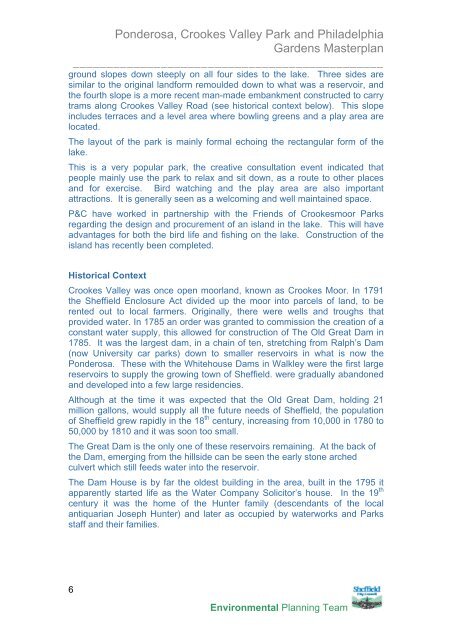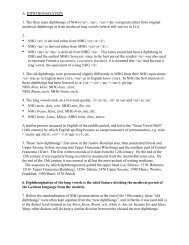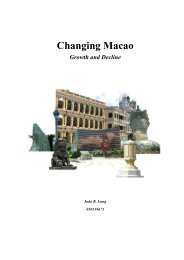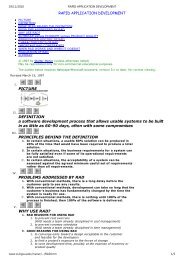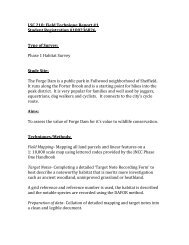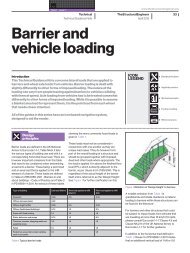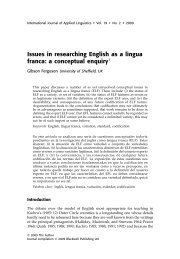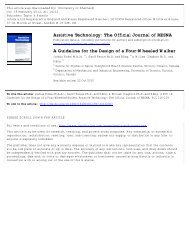Crookes Valley Park_Ponderosa_Philadelphia greenspace.pdf
Crookes Valley Park_Ponderosa_Philadelphia greenspace.pdf
Crookes Valley Park_Ponderosa_Philadelphia greenspace.pdf
You also want an ePaper? Increase the reach of your titles
YUMPU automatically turns print PDFs into web optimized ePapers that Google loves.
6<br />
<strong>Ponderosa</strong>, <strong>Crookes</strong> <strong>Valley</strong> <strong>Park</strong> and <strong>Philadelphia</strong><br />
Gardens Masterplan<br />
______________________________________________<br />
ground slopes down steeply on all four sides to the lake. Three sides are<br />
similar to the original landform remoulded down to what was a reservoir, and<br />
the fourth slope is a more recent man-made embankment constructed to carry<br />
trams along <strong>Crookes</strong> <strong>Valley</strong> Road (see historical context below). This slope<br />
includes terraces and a level area where bowling greens and a play area are<br />
located.<br />
The layout of the park is mainly formal echoing the rectangular form of the<br />
lake.<br />
This is a very popular park, the creative consultation event indicated that<br />
people mainly use the park to relax and sit down, as a route to other places<br />
and for exercise. Bird watching and the play area are also important<br />
attractions. It is generally seen as a welcoming and well maintained space.<br />
P&C have worked in partnership with the Friends of <strong>Crookes</strong>moor <strong>Park</strong>s<br />
regarding the design and procurement of an island in the lake. This will have<br />
advantages for both the bird life and fishing on the lake. Construction of the<br />
island has recently been completed.<br />
Historical Context<br />
<strong>Crookes</strong> <strong>Valley</strong> was once open moorland, known as <strong>Crookes</strong> Moor. In 1791<br />
the Sheffield Enclosure Act divided up the moor into parcels of land, to be<br />
rented out to local farmers. Originally, there were wells and troughs that<br />
provided water. In 1785 an order was granted to commission the creation of a<br />
constant water supply, this allowed for construction of The Old Great Dam in<br />
1785. It was the largest dam, in a chain of ten, stretching from Ralph’s Dam<br />
(now University car parks) down to smaller reservoirs in what is now the<br />
<strong>Ponderosa</strong>. These with the Whitehouse Dams in Walkley were the first large<br />
reservoirs to supply the growing town of Sheffield. were gradually abandoned<br />
and developed into a few large residencies.<br />
Although at the time it was expected that the Old Great Dam, holding 21<br />
million gallons, would supply all the future needs of Sheffield, the population<br />
of Sheffield grew rapidly in the 18 th century, increasing from 10,000 in 1780 to<br />
50,000 by 1810 and it was soon too small.<br />
The Great Dam is the only one of these reservoirs remaining. At the back of<br />
the Dam, emerging from the hillside can be seen the early stone arched<br />
culvert which still feeds water into the reservoir.<br />
The Dam House is by far the oldest building in the area, built in the 1795 it<br />
apparently started life as the Water Company Solicitor’s house. In the 19 th<br />
century it was the home of the Hunter family (descendants of the local<br />
antiquarian Joseph Hunter) and later as occupied by waterworks and <strong>Park</strong>s<br />
staff and their families.<br />
Environmental Planning Team


